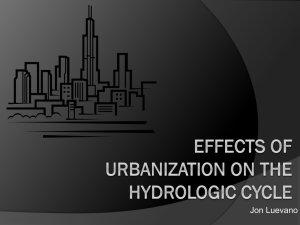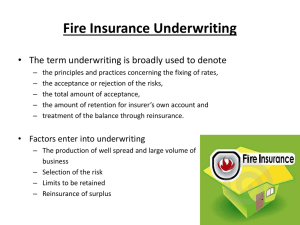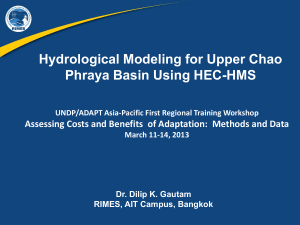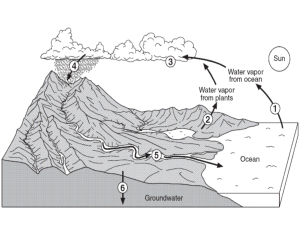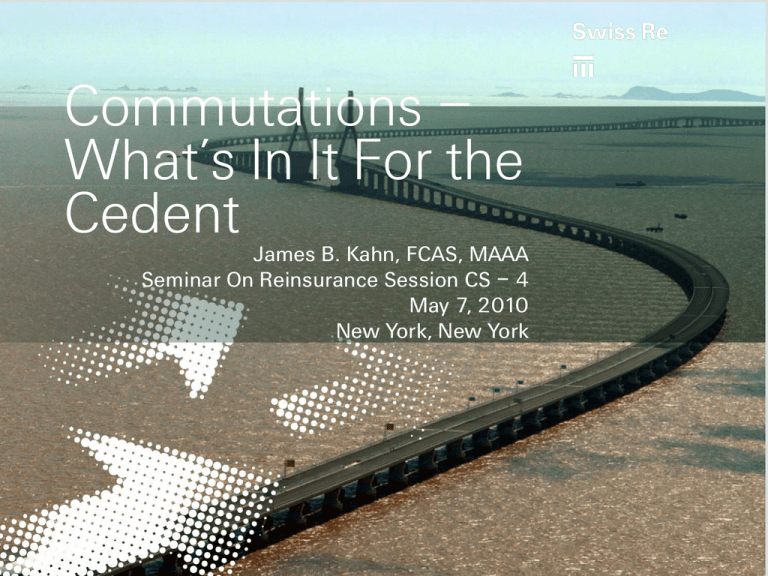
Commutations –
What’s In It For the
Cedent
James B. Kahn, FCAS, MAAA
Seminar On Reinsurance Session CS – 4
May 7, 2010
New York, New York
Background
2002 Call Paper on Runoff WC Reserving “Reserving for Runoff
Operations--A Real Life Claims Specific Methodology for Reserving a
Workers Compensation Runoff Entity” by James B. Kahn
Commutations not specifically discussed, but concepts of reserve reviews
can apply directly. Almost always a “runoff” block.
Lines of Business to consider in Claim by Claim analysis – Claims Made
Business, WC
Low Frequency/High Severity Lines of Business such as D&O and Medical
Malpractice have great uncertainty even from the individual claim
assessments
Workers Compensation - Claims and Actuarial Assumptions Used
Any line of business with an individual claims approach needs open
communication with Claims Department
2
Workers Compensation Example
Really no true IBNR claims
Number of claims will decrease over time so can become more
manageable
Lifetime reserves can be estimated relatively easily with mortality
table assumptions
Payment over many years allows for making adjustments to
parameters, escalation scenarios, etc.
Benefits set by statute – adjust for statutes and differences
between states directly on a claim by claim basis
Call paper example had many changes in recent history that
resulted in difficulty using traditional reserving methods.
3
Workers Compensation Example
(Continued)
Difficult to find history for runoff basis only from Industry sources
After 10 years of runoff, all Annual Statement information would be
contained in the ‘Prior Years’ Line of Schedule P
Distortions from increased usage of commutations for retrocessions or
changes to historical pooling percentages
Reopened information?
Settlement history?
Second Injury Fund recovery percentages?
Pro Rata ALAE vs. Included as Part of Loss?
Faster or slower reporting after a true runoff or liquidation?
4
Structure of WC Analysis
Using individual data, one can tailor make the analysis to be as
specific or general as desired
Vary Assumptions by Injury type classifications if desired such as PT,
PP, etc.
Claims discussion for yearly paid losses or consider actuarial
assumptions of averages
Claims discussion for changes in handling (internal and external)
5
Utilization of Mortality Tables
Using probability estimates for mortality and each claimant, the estimated
ground up and ceded estimates may likely not be explicit with stated
retention amounts
Using probability estimates for mortality and each claimant, you will never
reach the full limit for unpaid reserves as a non-zero probability exists that
claimant will not reach stated limit
Can use mortality tables to estimate claimant will live to the expected year
of life (like 2002 Call Paper), which would be a simpler procedure and
result in full limits losses in some cases
If using expected year of life estimation, you can probability weight longer
mortality assumptions to load for longer life expectancies
How to handle impaired mortality assumptions from claims department?
Escalation, discount, and mortality assumptions would all be integrated
with this projection
6
External Factors to Consider
Tort Reforms
MSA
Social Security Integration
Future changes in Healthcare???
7
“Internal” Factors to Consider
Reinsurance Agreements – Commutations, Insolvencies, Change
in Retention Limits and ALAE handling
Outside Recoveries (subrogation, 2nd Injury Funds, etc.)
Shift in open claimants may eventually go more towards those
who have suffered PT injuries and/or will not agree to
settlements – will there be a change in philosophy going
forward?
Definitions of Closed Claims – a change could impact definitions
of reopened claims and would need to be adjusted for in final
calculations
8
Development of Reserve – Claims
Rollup
Medical
Indemnity
ALAE
Recoveries/Second Injury Funds
Discount
Reinsurance Cessions
Settlements
Reopened Claims
9
Indemnity Reserve
In its simplest form, should be remaining months of lifetime times
an amount determined by statute
Straight average of past years may overstate given early
vocational rehabilitation costs for some claimants
Selected yearly paid amounts from claims department or
specified
COLA applies in some states, and may have varying degrees of
caps per claimant
Social Security Disability offsets varies by claimant
For Lifetime claimants, it is not very difficult to get to amounts in
excess of $1M for relatively young claimants
10
ALAE Reserve
Will need to know how ALAE treated in cessions
Unlike other LOBs, older WC claims may not have as high a % of
ALAE to loss as less mature claims
Decrease in ALAE as a percentage of loss over the course of time
is counter to common thought as claims begin to mature (Reverse
Salzmann)
Can estimate with claims input, or select percentage of loss
benchmarks
As loss begins to pierce retention and even exceed per claim
limits, ALAE cessions under Pro Rata policies will vary
In theory, you would expect a runoff block of business to have
fewer claims willing to accept settlements over time – in such a
case, may result in fewer ALAE fees going forward
11
Average Yearly
Payment Amount
ABC Average Calendar Year Payments from Accident Date for
Open Claims Not Including Claims at Maximum Reinsurance
Retention
16,000
14,000
12,000
10,000
8,000
6,000
4,000
2,000
0
1
2
3
4
5
6
7
8
9
10
11
12
13
14
Years Since Accident Date
12
15
16
17
Medical Reserve
Looked at historical CY payment by AY of remaining body of open
claims
After first 4 years following an accident, medical claims appear to
follow a “U-Shaped” payment pattern over time as forces of
inflation and utilization interact – similar patterns seen for
virtually all Accident Years
A runoff block may be at or beyond the initial “u” bottom and be
escalating
Adjust claims for escalation of medical costs. Should also be
aware of impact of healing and repetitive treatment costs as
opposed to initial surgeries and intensive early treatments
13
Medical Reserve (Continued)
Scenarios Testing – See sensitivity of different escalation
scenarios after recoveries and reinsurance cessions
Different escalation for claims in runoff beyond initial point after
injury?
14
Recoveries/Second Injury Funds
SIF and Subrogation Recoveries inure to the benefit of reinsurers,
but may take considerable time to receive share of funds
While many states move toward phasing out and removing Second
Injury Funds, still apply to many runoff WC claimants
May cover 100% of losses or a lesser percentage based on
statutes, accident year, and Board determinations.
ALAE should not be covered by SIF
Companies may not account for recovery until received. Long lag
of amounts due could be larger than nominal reserves projected
resulting in negative IBNR
Reinsurers see benefit of second injury fund coverage as well
15
Claim Settlement Background
As mentioned, not figures available Industrywide
Outside claim by claim analysis as a bulk figure or try to estimate within
particular individual claimants
Settlements could lower ultimate loss amounts below retentions, which
would also impact pro rata ALAE calculations
Impact on nominal reserves impacted when removing long discount?
Change in philosophy going forward as to settlements?
Have there been changes in settlements due to macro events in the
economy? Other utility factors of claimants?
Does recent MSA provisions lead to fewer settlements? Higher amounts
on current settlements, etc.? Company still has the ability to refuse
settlement after MSA approval or disapproval
16
Reopened Claims Example
Calculation of IBNR for New and Reopened Claims
Loss Amounts in ($Actual)
Month
1997
(1)
Calendar Year
1998
(2)
1999
(3)
2000
(4)
January
99,792
168,117
68,147
204,587
February
90,070
164,825
202,870
24,897
March
131,895
149,756
339,573
82,909
April
133,177
291,399
152,243
157,368
May
157,488
147,232
123,982
73,755
June
147,861
153,989
138,025
73,505
July
181,954
189,706
86,777
39,136
August
90,307
197,846
186,403
96,632
September
110,346
163,048
80,604
222,456
October
97,915
79,213
137,785
November
140,764
153,355
140,633
December
153,168
124,010
477,944
Total
1,534,737
1,982,496
2,134,986
975,245
Yearly Change
Average
127,895
165,208
177,916
108,361
Avg. Ex Hi Lo
126,271
161,188
158,890
103,985
5.85%
6.82%
Median
132,536
158,519
139,329
82,909
15.68%
Selected
132,536
158,519
139,329
82,909
15.68%
Calculation of IBNR associated with New and Reopened Claims=
(A):
Average Monthly Payment for Current Year:
108,361
(B):
Average Yearly Payment for Current Year equals (A)*12:
1,300,327
(C):
Selected Average Yearly Decrease in Amount:
(D):
Ultimate IBNR for New and Reopened equals (B)/(C)-(B):
17
15.68%
6,991,030
Discount
Biggest additional adjustment made for commutation presentation
from nominal reserving procedure
Can have pretty significant discount for WC especially when using
mortality tables and long life expectancies
Often one of the biggest difference discussions between cedent
and reinsurer when dealing with commutations
Flat interest rate can be used, and is easy to explain and calculate,
but what is the long term average? If a certain number of basis
points above risk free rate, then how many?
18
Discount (Continued)
Sometimes, can establish “yield curve” using published treasury
instruments, but same economic uncertainty as flat interest rate.
Additionally, estimates have changed significantly over the last
several years
With yield curves, you can also consider a “spread above risk-free
rate” or incorporate another measure of adjustment such as
blending risk-free rates with corporate bond rates to produce an
adjusted yield curve
19
Development of Reserve – Claims
Rollup (Revisited)
Medical
Indemnity
ALAE
Recoveries/Second Injury Funds
Discount
Reinsurance Cessions
Settlements
Reopened Claims
20
Conveyance of Results from Reinsurer
to Cedent or Vice Versa
Reserves for a block of claims have been established after
accounting for all the factors and individual components
Negotiation – Now the fun begins!!
21
Thank you
Basic Copyright Notice & Disclaimer for Swiss Re
Presentations provided to External Parties
©2009 Swiss Re. All rights reserved. You are not permitted to create any
modifications or derivatives of this presentation without the prior written
permission of Swiss Re.
This presentation is for information purposes only and contains non-binding
indications as well as personal judgment. It does not contain any
recommendation, advice, solicitation, offer or commitment to effect any
transaction or to conclude any legal act. Any opinions or views expressed are
of the author and do not necessarily represent those of Swiss Re. Swiss Re
makes no warranties or representations as to this presentation’s accuracy,
completeness, timeliness or suitability for a particular purpose. Anyone shall at
its own risk interpret and employ this presentation without relying on it in
isolation.
In no event will Swiss Re or one of its affiliates be liable for any loss or
damages of any kind, including any direct, indirect or consequential damages,
arising out of or in connection with the use of this presentation.
23

